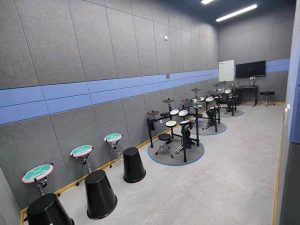Sound absorbing panels are not just for professional recording studios anymore. With more people working from home and seeking high-quality audio experiences, these panels are becoming increasingly popular in home settings.
If you’re a homeowner looking to improve your living space or a sound engineer aiming for better acoustics, sound absorbing panels are a valuable investment. Here’s everything you need to know about them.

Introduction to Sound Absorbing Panels
Sound absorbing panels are materials used to reduce sound reflections within a room. Unlike soundproofing materials, which block sound from entering or leaving a space, these panels focus on improving the sound quality within a room.
The main purpose of sound absorbing panels is to capture sound waves that would otherwise reflect off hard surfaces such as walls, ceilings, and floors. These panels are generally constructed from porous materials that trap sound waves, converting them into a small amount of heat energy. This process minimises echo and reverberation in the room, leading to clearer sound quality.
Benefits of Sound Absorbing Panels in Home and Professional Settings
Home Settings
- Enhanced Sound Quality: Whether you’re watching a movie, listening to music, or playing video games, sound absorbing panels can make a significant difference in the audio experience.
- Improved Home Office: With many people working from home, reducing background noise is essential for clear communication during virtual meetings.
- Better Sleep Environment: Sound absorbing panels can help create a quieter and more peaceful bedroom.
Professional Settings
- Recording Studios: Achieve professional-quality sound recordings by minimising unwanted echoes.
- Offices: Reduce noise distractions and improve employee concentration.
- Restaurants and Cafes: Enhance the customer experience by creating a more comfortable acoustic environment.
Different Types of Sound Absorbing Panels
Foam Panels
Foam panels are lightweight, affordable, and easy to install. They come in various shapes and sizes, making them a popular choice for home use.
Fabric-Wrapped Panels
These panels offer excellent sound absorption and come in a variety of colours and patterns, allowing them to blend seamlessly with your interior decor.
Bass Traps
Specifically designed to absorb low-frequency sounds, bass traps are essential for recording studios and home theatres.
Acoustic Baffles
Hanging from the ceiling, acoustic baffles are ideal for large spaces like open-plan offices and restaurants.
Installation Tips for Maximum Effectiveness
- Placement: For the best results, place panels at the first reflection points—areas where sound waves first hit a surface after leaving the source.
- Spacing: Panels should be evenly spaced around the room to ensure consistent sound absorption.
- Height: Mount panels at ear level when sitting or standing to target the most critical listening areas.
- Layering: In rooms with significant echo problems, consider layering different types of panels for a more comprehensive solution.
Maintenance and Care of Sound Absorbing Panels
Maintaining a sound absorbing panel is relatively straightforward, but it’s essential to ensure they remain in optimal condition for maximum effectiveness. Regularly dust your panels with a soft cloth or vacuum with a brush attachment to remove accumulated dust and debris. For fabric-wrapped panels, spot-clean any stains using a mild detergent and water, being careful not to saturate the material.
If your panels are exposed to high humidity or damp conditions, consider a dehumidifier to prevent mould and mildew growth. Periodically check for any signs of wear and tear, and replace panels that have deteriorated over time to maintain consistent sound quality in your space. Proper maintenance ensures your investment continues to provide value, whether in a home or professional setting.
Conclusion
Sound absorbing panels are a game-changer for anyone looking to improve their acoustic environment. Whether you’re a homeowner wanting a better audio experience or a sound engineer aiming for professional-quality recordings, these panels offer an effective and stylish solution.
